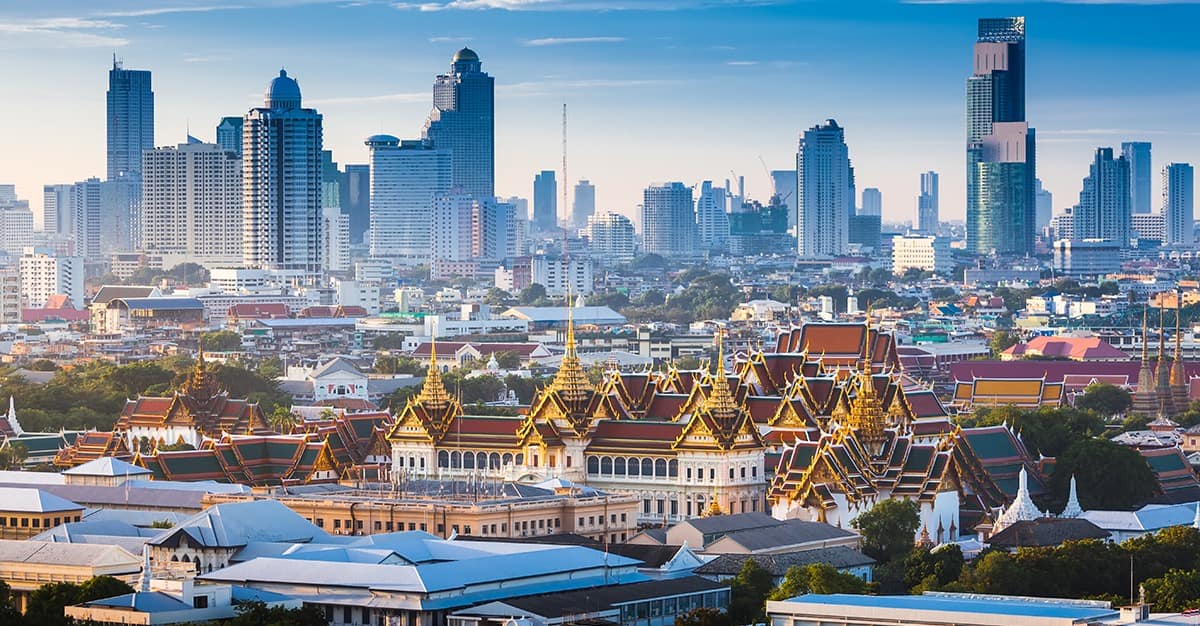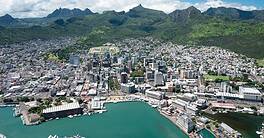Located at the center of the ASEAN region, with direct links to China, Thailand is piquing investors’ interest.

| VITAL STATISTICS |
|---|
| Location: Southeast Asia |
| Neighbors: Myanmar, Laos, Cambodia, Malaysia |
| Capital city: Bangkok (pop. 11 million) |
| Population (2023 est.): 69.8 million |
| Official language: Thai (90%); other (10%) |
| 2022 GDP: $506 billion (nominal), per capita (expected): $17,100. Growth (2022): 2.6% (est.); (2021) 1.5% |
| Urban population: 53.6% |
| Life expectancy at birth: 78 |
| Inflation (2022): 1.23% |
| Unemployment rate: 0.88% |
| Total labor force: 38 million (2022 est.) |
| Sectors: agriculture, 8.2%; industry, 36.2%; services, 55.6% |
| Currency: Bhat |
| Literacy rate: 94.1% |
| Corruption Perceptions Index rank (2021): 110/180 |
| Available investment incentives: Tax holidays in investment zones and for eligible green investments; tax incentives and discounts for individuals and entities invested in the Eastern Economic Corridor. |
| Pros |
|---|
| Constitutional monarchy since 1936 |
| Forthcoming general election—all parties stressing FDI and economic growth |
| Vibrant energy sector, PTT NOC |
| Strong relations with People’s Republic of China; direct high-speed rail links to China under development. |
| Headquarters alternative to very costly Singapore |
| 1966 Treaty of Amity with US allows preferential ownership structures |
| Revamped Board of Investment has received very positive reports from recent investors |
|
CONS |
|---|
|
Political uncertainty and continuing role of army in politics |
|
Undeveloped infrastructure (although improving) |
|
Aging population and low birth rate |
|
Lack of availability of English-speaking resources |
As investors scratch their heads over China’s increasingly cautious attitude toward foreign capital—with no near-term expectation of clarity—many are taking a fresh look at another economy with close ties to the East Asian behemoth: Thailand. With its population of 69 million and a high-speed rail link into China due to open to travelers in 2028, Thailand’s economy is already projected to grow 3.6% in 2023, up from 2.6% last year, on stronger private consumption.
The World Bank bases that projection in part on a rapid recovery in the tourism sector and strong pent-up demand following China’s reopening. Thailand’s newly revamped Board of Investment (BOI), meanwhile, is offering incentives for inward investment in key areas, along with a chain of special economic zones.
“We handle FDI [foreign direct investment] projects and have seen a distinct increase in investment activity over the past few years,” says Aime Pinyapa Somphong, managing partner at TWLS Law Group in Bangkok. “The uptick was evident even before Covid-19, but from mid-2022 it has been especially strong.” The biggest source of interest is from China, Aime notes.
Although Thai voters recently chose reformers over the country’s longstanding military-political leadership, it remains to be seen how much change can be wrought through parliamentary wrangling.
The BOI is eager to encourage the trend. In 2021, it unveiled the Bio-Circular-Green Economic Model, a strategic plan that aims to boost Thailand to its next level of development by focusing on four industries: agriculture and food; medical and wellness; bioenergy, biomaterial, and biochemical; and tourism and the creative sector. The BCG includes tax incentives for foreign investors in Thailand that can help achieve BCG’s goal of net-zero emissions.
Economic Outlook
While the Bank of Thailand has trimmed its growth forecast for 2023, citing external risks and an expected global slowdown, Piti Disyatat, director of economic research in the bank’s Monetary Policy Group, said recently that he expects growing strength in the tourism sector to lessen the impact of any global softening.
“The economy has good momentum, while inflation, albeit easing, remains higher than that in the past,” Piti says, “so [rate] normalization will have to continue. Our task going forward is to ensure that the economic recovery is stable.” He still projects Thai GDP to grow close to 4% in 2023, ahead of the World Bank’s projection, and for the baht to continue to strengthen against the US dollar.
While China and India are much larger economies, Thailand is not perceived as posing as many problems for outside investors, according to Chris Cracknell, chairman of Grant Thornton in Thailand.
“There is a sense that Southeast Asia—and specifically ASEAN member countries with mutual free trade agreements already in place—are the place to land if you can’t do China due to supply uncertainty and political risk,” he says. Thais refer to China as “big brother,” he notes, pointing out that Thailand is well positioned within ASEAN to offer a base for manufacturing and distribution with direct and improving logistical links to China to the north as well as the rest of Asia. The special economic zones on its eastern seaboard have attracted much inward interest, he adds.
Election Reveals Consensus
The profile and direction of future economic growth were issues in last month’s national elections. “After the bruising impacts of Covid-19, there is an awareness on all sides that the economic base needs to be broadened away from agriculture and tourism, which between them comprise 60% of GDP,” says Peter Hone, an energy industry expert with 30 years of experience in Thailand and the region. “Both the incumbent prime minister [Prayut Chan-o-cha, who had served since seizing power in a military coup in 2014] and campaigning opposition leaders have emphasized the importance of new FDI,” promising to continue investment in the Eastern Economic Corridor (EEC) and focus more on the neglected southern provinces bordering Malaysia.
The EEC, a special economic zone in eastern Thailand straddling the three provinces of Chachoengsao, Chonburi and Rayong, was established in 2017 and enjoys significant tax and capital advantages. “The concessions in this zone, and the growing infrastructure, have been major factors in attracting investment,” says Aime. The area boasts new ports and other infrastructure, and new projects including a semiconductor wafer fabrication plant to be built by Chinese investors.
Hat Yai, the largest city in the southern region, could be the next economic powerhouse in the region,” Niphon Bunyamanee, deputy leader of the Thai Democrat party, said recently, given the political tension in Hong Kong and land scarcity issues in Singapore.”
What sectors are likely to see the most growth? “Medical and health tourism,” says Hone, “and a strong move towards sustainability via the BCG, which stresses the development not merely of renewable energy but also of alternative sources of protein in the food chain. One Chinese waste management company already collects waste and plastic scrap and converts it to electricity or to new plastic pallets (PDPA).”
Thai leaders and planners are sensitive to how their country stacks up in comparison with Singapore, which is seen as the benchmark for governance and stability in the region, says Cracknell, and is now offering “inter alia regional operating headquarters tax concessions” to lure multinationals out of the high-cost island state. Along with these are import/export tax exemptions on approved projects. “Significantly, Thailand is now allowing foreign [corporate] ownership of land for the first time. For a long time, a local partner was required.”
Door Widening for FDI
US investors and businesses have long had favored access to the Thai market. The Treaty of Amity and Economic Relations Between the Kingdom of Thailand and the US, inked in 1966, allows—uniquely—for American citizens and businesses incorporated in the US or in Thailand to maintain a majority shareholding or to wholly own a company in Thailand and thereby engage in business on the same basis as would a Thai national. Under the treaty, these companies are also exempt from most of the restrictions on foreign investment imposed by the Thai Foreign Business Act of 1999.
Nevertheless, the UK-based Lucy Group has made a major commitment to the Thai EEC.
“When we started to seriously diversify around 2010, we decided we needed another manufacturing base,” says Carl Sellick, regional CEO of Lucy Group, which supplies electrical distribution systems and switch gear across the world. “We chose Thailand because, under the rules, we didn’t need a local partner—unlike Malaysia. We decided to invest in the EEC. Unlike our competitors ABB, Siemens and Schneider, we manufacture in Thailand, and as long as we re-export our products, are free of local tax.”
Lucy Group benefits from a seven-year tax holiday on profits, with taxes limited to 50% of the normal rate for the next 10 years. Thailand provides a base for the company in ASEAN as well as points north to China.
“We have been delighted by our success in Thailand,” says Sellick. “Nearly 20% of our product is now sold here, 40% in ASEAN under the terms of the regional free trade agreement and the rest across APAC.”
The Made in Thailand label “is very important to our hosts,” Sellick points out, “and at this point many government bodies choose to buy our products; 75% of the 20% sold locally goes to government-related companies via the MEA [Metropolitan Electricity Authority], which are generally easy to deal with. We made the right decision.”
Early signs this year suggest that other foreign companies and investors see Thailand the same way, says Aime. “We expect FDI to increase this year and are getting many more enquiries. Many investors are seeing that Thailand enjoys both domestic scale and increasing connectivity with the key markets of the PRC—to the north—and the ASEAN free-trade area with its 800 million people.”
Cross-party political consensus on the need to develop a southern economic zone and a new growth- and infrastructure-oriented government in Malaysia also augur well for regional rail and road infrastructure.



